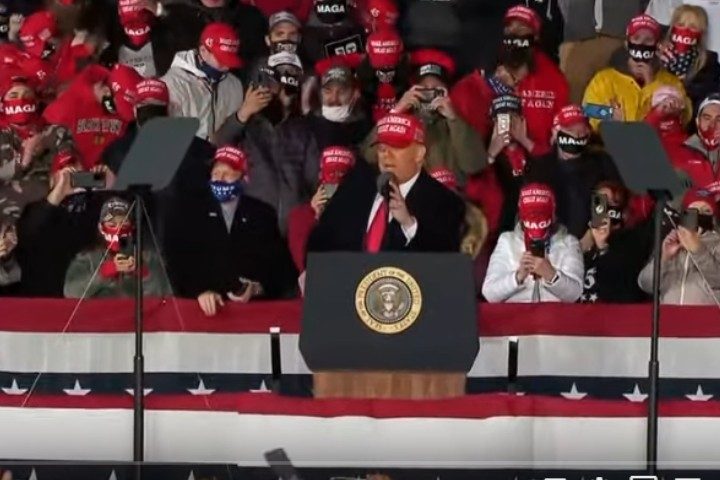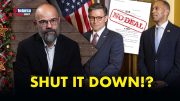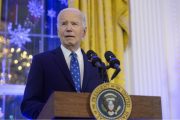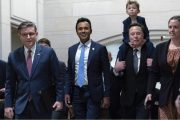
Large rallies for President Trump are not what the leftist media and Trump’s other hysterical critics call “superspreaders.”
Chinese Virus cases are just as likely to decrease as increase after a large rally, the Daily Caller found.
The DC examined data for coronavirus cases after nearly two dozen rallies to arrive at the welcome conclusion, which would be good news for Democrat presidential candidate Joe Biden if he could actually get anyone to attend one of his campaign events.
That said, we now know this: President Trump not only defeated the Asiatic pathogen when it infected him, but also is not responsible for so-called COVID-19 outbreaks after his boisterous fans gather to cheer him.
The Report
The webzine “reviewed case data provided by state and county authorities where the Trump campaign held public events,” it explained in Friday’s report:
The number of new infections on the day that rallies took place was compared to the number of new infections one week, two weeks and one month later in each location to determine if there was a significant increase in new infections post-rally. Seven-day averages of new infections were used where available.
Trump, the DC continued, has organized 23 rallies since June 20 in Tulsa, Oklahoma, his first big gathering after public officials panicked unnecessarily and shut down the country.
Thousands gathered indoors in Oklahoma’s second-largest city to welcome the president, and statewide new cases were 32% higher one week after the rally. However, cases in Tulsa County actually trended downward during the two weeks after the rally, and a spokesman with the Oklahoma State Department of Health told the Daily Caller that they don’t have “hard data” that connects the rally with any increase in cases. The Tulsa Health Department does not publicly release information on what events Covid-19 cases could have been contracted.
Examination of the other 22 rallies found similar results. Roughly half of the events clearly did not precede an upward swing in the rate of Covid-19 infections in the host state or county. This includes campaign stops during August and September in Minnesota, Pennsylvania, North Carolina, Michigan, Nevada and Ohio. The remaining rallies occurred around the times of what appear to be increases in Covid-19, but no evidence can prove a link between the President’s visits and the outbreaks.
After late-summer rallies in Old Forge and Moon Township, Pennsylvania, “data from both Lackawanna and Allegheny County show increases in Covid-19 infections in the weeks following the rallies.” Yet public health officials told the webzine they could not link the rallies and the rise in virus cases.
Likewise with public health authorities in Manchester, New Hampshire. “We are not aware of any cases linked to the Trump rally on August 28,” a spokeswoman told the webzine.
A spokeswoman for the Ohio Department of Health said, “There have been no cases linked to the rally” on September 21 in Swanton.
Ditto for a rally on September 12 in Minden, Nevada.
An uptick in virus cases in Wisconsin occurred before Trump held rallies there.
The DC did find one suspect event:
Trump’s Sept. 18 rally in Bemidji, Minn., was the only event we investigated that ended up with multiple connected cases of Covid-19. Doug Schultz, Information Officer for the Minnesota Department of Health says they have identified nine individuals who attended the rally and later tested positive for Coronavirus. The rally was attended by thousands of supporters.
Schultz added that “it’s always difficult to attribute increases or decreases in daily case numbers to specific causes as there can be multitude of factors influencing the numbers.”
Dr. Michael Osterhom, director of the Center for Infectious Disease Research and Policy at the University of Minnesota, told the webzine that poor contact tracing might explain the results of the DC’s study. Then again, he continued, many rallies are outside, where the virus doesn’t seem to spread:
Osterholm further said that more routine indoor gatherings are still the primary vectors of transmission, something multiple health department officials echoed to the Caller. While the media focuses on large public gatherings and blames Trump rallies for increasing spread, they said it is still weddings, funerals, parties, and other such events that are driving this pandemic.
As Dr. Osterholm pointed out, people who attend large gatherings like protests or rallies are “likely to be gathering amongst themselves before and after the events” as well, and these are people who are more likely to be out living their lives “normally” than others, potentially putting them at an increased risk of infection. An individual going to a rally and later testing positive does not necessarily show that the virus was contracted at the rally.
Media Myths
The notion that outdoor rallies are “superspreaders” is one of the media’s relentless anti-Trump narratives.
A Google search for “trump rallies are superspreaders” yields 6.5 million results. Attaching a rally to the search leads to articles that falsely call it a superspreader event when, in fact, the data show otherwise.
One article at leftist Bill Moyers’ website called them “crime scenes.”



